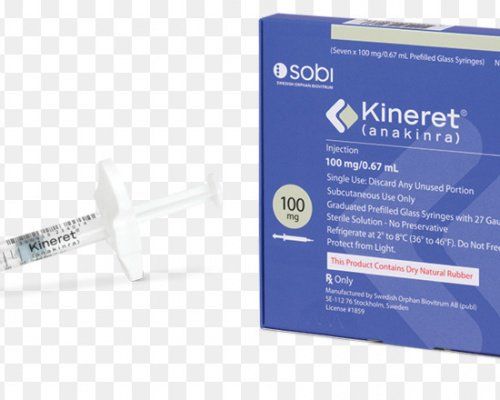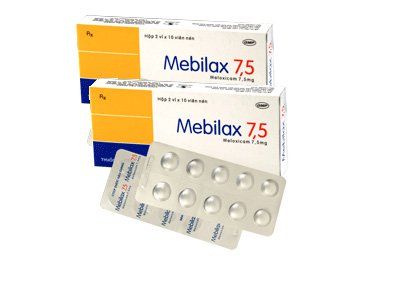This is an automatically translated article.
Piroxicam is an uncommon active ingredient of the non-steroidal anti-inflammatory group. So what is the use of Dinbutevic, a brand-name drug containing the active ingredient Piroxicam, and how should it be used?
1. What is Dinbutevic drug?
Dinbutevic brand-name drug contains the main active ingredient Piroxicam 10mg. In addition, in each Dinbutevic tablet, there are excipients such as Lactose, starch, talc, magnesium stearate, sodium starch glycolate, empty capsule number 0 (blue-white).
The active ingredient Piroxicam in Dinbutevic belongs to the oxicam group of non-steroidal anti-inflammatory drugs. However, the exact mechanism of action of Dinbutevic is still unknown. According to the general mechanism of NSAIDs, the effect of Piroxicam may be due to inhibition of the enzyme Prostaglandin synthetase, thereby preventing the production of Prostaglandin, Thromboxan and other products of the Enzyme Cyclooxygenase. Besides, the active ingredient Piroxicam also inhibits the activation of neutrophils, so the anti-inflammatory effect is related to the inhibition of Proteoglycanase and Collagenase enzymes in cartilage. Another effect of Piroxicam is antiplatelet inhibition.
Because piroxicam inhibits prostaglandin synthesis in the kidneys, Dinbutevic causes decreased blood flow to the kidneys. This effect is especially important, so it should be taken into account when using Dinbutevic in patients with renal failure, heart failure and liver failure and also cases with changes in plasma volume.
2. Indications and contraindications of Dinbutevic
Indications of the drug Dinbutevic for the purpose of antibiotics and/or pain relief in the following diseases:
Rheumatoid arthritis, other osteoarthritis and degenerative joint diseases; Ankylosing spondylitis ; Certain acute musculoskeletal diseases or sports injuries; The drug Dinbutevic has the ability to relieve pain, so it is indicated in dysmenorrhea and pain after surgery; A pathology that can appoint Dinbutevic is acute gout. Dinbutevic medicinal products are contraindicated in the following cases:
Patients with hypersensitivity to the main active ingredient Piroxicam; Patients with acute gastric and duodenal ulcer disease; The patient has a history of bronchospasm, bronchial asthma, nasal polyposis and Quincke's edema; Dinbutevic is contraindicated in patients with urticaria, allergic reactions after taking aspirin and other non-steroidal anti-inflammatory drugs; Patients with cirrhosis of the liver , severe heart failure or at high risk of bleeding should also not take Dinbutevic ; Patients with renal insufficiency with a glomerular filtration rate less than 30 ml/min are contraindicated with Dinbutevic.
3. Dosage of the drug Dinbutevic
The recommended adult dose is 20mg Piroxicam (equivalent to 2 Dinbutevic tablets), taken once daily. Some patients may respond to 10 mg/day (1 Dinbutevic tablet) and others up to 30 mg daily, taken once or twice.
Dinbutevic should not be used in children. However, the active ingredient Piroxicam can be used in children 6 years of age and older who have been diagnosed with rheumatoid arthritis. The specific dose depends on the weight of the child:
Children under 15 years take a dose of 5mg/day; Children 16-25kg recommended dose 10mg/day; Children 26-45kg use a dose of 15mg/day; Children weighing 46kg and over are recommended to take 20mg/day.
4. Dinbutevic side effects
Statistics show that more than 15% of cases treated with Piroxicam appear some unwanted reactions. Most of them are images on the gastrointestinal tract, but this does not affect the effectiveness of the treatment.
Some common side effects of Dinbutevic:
Stomatitis, loss of appetite, epigastric pain, nausea, dyspepsia, diarrhea and constipation; Dinbutevic may reduce the red blood cell count with Hematocrit and lead to anemia, decreased white blood cell count or increased eosinophils; Itching, skin rash; Dizziness; Increased blood urea and creatinine; Headache, irritability; Tinnitus; Edema. Less common side effects of Dinbutevic ;
Abnormal liver function tests, jaundice; Hepatitis; Gastrointestinal bleeding, perforation and ulceration; Dry mouth; Decreased platelet count, petechiae, bruising, or bone marrow depression; Sweating, red rash or Stevens - Johnson syndrome; Depression, insomnia, restlessness, irritability; Hematuria, interstitial nephritis and nephrotic syndrome; Fever, symptoms similar to other pneumonia; eye swelling, blurred or irritated vision; Increased blood pressure and worsening of congestive heart failure may occur with Dinbutevic. Some rare undesirable manifestations of Dinbutevic:
Pancreatitis; Nail loss, hair loss; Restlessness, restlessness, hallucinations, mood swings, paresthesia confusion; It's difficult; Temporary loss of hearing; Anemia due to hemolysis.
5. Some cautions when taking Dinbutevic
Dinbutevic should be used with caution in the following cases:
Elderly patients; Have a bleeding disorder, a history of cardiovascular disease or a history of peptic ulcer, liver or kidney failure; The patient is being treated with diuretics; Like other inhibitors of prostaglandin synthesis and release, Piroxicam also increases the risk of residual pulmonary hypertension in the neonate, due to pre-natal closure of the ductus arteriosus if Dinbutevic is taken by the mother during the third trimester. pregnancy. Active ingredient Piroxicam also inhibits labor, prolongs pregnancy, and minimizes toxicity on the gastrointestinal tract in pregnant women. Dinbutevic should not be used in the last 3 months of pregnancy or near the time of labor.
Piroxicam may be excreted in breast milk. However, because the safety of Dinbutevic has not been established during breast-feeding, caution should be exercised in this population.
There have been no reports of Dinbutevic affecting the ability to drive and use machines.
6. Dinbutevic drug interactions
When taking Dinbutevic with coumarin-type anticoagulants and drugs with high protein binding ability, the physician should closely monitor the patient to adjust the dose of Piroxicam accordingly. It should be noted that because of its high protein binding ability, Dinbutevic can be used for the purpose of pushing other drugs out of plasma proteins. Dinbutevic should not be co-administered with Aspirin, because it may lower the plasma concentration of Piroxicam, and the effectiveness of Dinbutevic is not better than aspirin with the risk of unwanted effects. also increase. Concomitant treatment with Dinbutevic with lithium leads to an increased risk of lithium toxicity because Piroxicam increases plasma concentrations of lithium. This drug interaction requires close monitoring of lithium plasma concentrations. Concomitant administration of Dinbutevic with antacids did not affect plasma concentrations of piroxicam. Dinbutevic contains the active ingredient Piroxicam. The drug is indicated in cases of pain relief, anti-inflammatory. To ensure the effectiveness of treatment and avoid unwanted side effects, patients need to strictly follow the instructions of the doctor, professional pharmacist.Follow Vinmec International General Hospital website to get more health, nutrition and beauty information to protect the health of yourself and your loved ones in your family.
Please dial HOTLINE for more information or register for an appointment HERE. Download MyVinmec app to make appointments faster and to manage your bookings easily.













